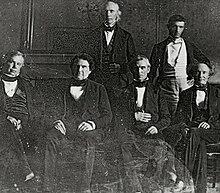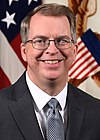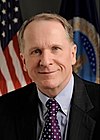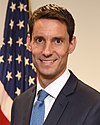begin quote from:
Cabinet of the United States
This article may be affected by a current event. Information in this article may change rapidly as the event progresses. Initial news reports may be unreliable. The last updates to this article may not reflect the most current information. (January 2021) (Learn how and when to remove this template message) |
| Current: Cabinet of Joe Biden | |
 | |
| Agency overview | |
|---|---|
| Formed | March 4, 1789 |
| Type | Advisory body |
| Headquarters | Cabinet Room, White House, Washington, D.C. |
| Employees | 23 members: |
| Agency executive | |
| Key document |
|
| Website | www.whitehouse.gov |
 |
|---|
| This article is part of a series on the politics and government of the United States |
The Cabinet of the United States is a body consisting of the vice president of the United States and the heads of federal executive departments of the executive branch of the federal government of the United States which is regarded as the principal advisory body to the President of the United States. The President is not formally a member of the Cabinet. The heads of departments, appointed by the president and confirmed by the Senate, are members of the Cabinet, and acting department heads also sit at Cabinet meetings whether or not they have been officially nominated for Senate confirmation. There are also other positions that have Cabinet-rank status, generally referred to as Cabinet-level positions. The President can unilaterally designate senior advisers from the Executive Office of the President or heads of other federal agencies as members of the Cabinet. The Cabinet does not have any collective executive powers or functions of its own, and no votes need to be taken. As of January 15, 2021, there were 23 members of Cabinet: the Vice President, 15 department heads (of which 4 were acting), and 7 were Cabinet-level members.
The members of the Cabinet serve at the pleasure of the president, who can dismiss them at any time without the approval of the Senate, as affirmed by the Supreme Court of the United States in Myers v. United States (1926), or downgrade their Cabinet membership status. The President can organise the Cabinet as he sees fit, such as instituting committees. Like all federal public officials, Cabinet members are also subject to impeachment by the House of Representatives and trial in the Senate for "treason, bribery, or other high crimes and misdemeanors".
The Constitution of the United States does not explicitly establish a Cabinet. The Cabinet's role, inferred from the language of the Opinion Clause (Article II, Section 2, Clause 1) of the Constitution is to provide advice to the President. Additionally, the Twenty-fifth Amendment authorizes the vice president, together with a majority of the heads of the executive departments, to declare the president "unable to discharge the powers and duties of his office". The heads of the executive departments are—if eligible—in the presidential line of succession.
History[edit]
The tradition of the Cabinet arose out of the debates at the 1787 Constitutional Convention regarding whether the president would exercise executive authority solely or collaboratively with a cabinet of ministers or a privy council. As a result of the debates, the Constitution (Article II, Section 1, Clause 1) vests "all executive power" in the president singly, and authorizes—but does not compel—the president (Article II, Section 2, Clause 1) to "require the Opinion, in writing, of the principal Officer in each of the executive Departments, upon any Subject relating to the Duties of their respective Offices".[1][2] The Constitution does not specify what the executive departments will be, how many there will be, or what their duties will be.
George Washington, the first president of the United States, organized his principal officers into a Cabinet, and it has been part of the executive branch structure ever since. Washington's Cabinet consisted of five members: himself, Secretary of State Thomas Jefferson, Secretary of the Treasury Alexander Hamilton, Secretary of War Henry Knox and Attorney General Edmund Randolph. Vice President John Adams was not included in Washington's Cabinet because the position was initially regarded as a legislative officer (president of the Senate).[3] It was not until the 20th century that vice presidents were regularly included as members of the Cabinet and came to be regarded primarily as a member of the executive branch.
Presidents have used Cabinet meetings of selected principal officers but to widely differing extents and for different purposes. Secretary of State William H. Seward and then-professor Woodrow Wilson advocated the use of a parliamentary-style Cabinet government. But President Abraham Lincoln rebuffed Seward; and Wilson, after becoming president, would have none of it in his administration. In recent administrations, Cabinets have grown to include key White House staff in addition to department and various agency heads. President Ronald Reagan formed seven sub-cabinet councils to review many policy issues, and subsequent presidents have followed that practice.[2]
Federal law[edit]
In 3 U.S.C. § 302 with regard to delegation of authority by the president, it is provided that "nothing herein shall be deemed to require express authorization in any case in which such an official would be presumed in law to have acted by authority or direction of the president." This pertains directly to the heads of the executive departments as each of their offices is created and specified by statutory law (hence the presumption) and thus gives them the authority to act for the president within their areas of responsibility without any specific delegation.
Under the 1967 Federal Anti-Nepotism statute, federal officials are prohibited from appointing their immediate family members to certain governmental positions, including those in the Cabinet.[4]
Under the Federal Vacancies Reform Act of 1998, an administration may appoint acting heads of department from employees of the relevant department. These may be existing high-level career employees, from political appointees of the outgoing administration (for new administrations), or sometimes lower-level appointees of the administration.[5]
Confirmation process[edit]
The heads of the executive departments and all other federal agency heads are nominated by the president and then presented to the Senate for confirmation or rejection by a simple majority (although before the use of the "nuclear option" during the 113th United States Congress, they could have been blocked by filibuster, requiring cloture to be invoked by 3⁄5 supermajority to further consideration). If approved, they receive their commission scroll, are sworn in and then begin their duties.
An elected vice president does not require Senate confirmation, nor does the White House chief of staff, which is an appointed staff position of the Executive Office of the President.
| Office | showSenate confirmation review committee |
|---|
Salary[edit]
The heads of the executive departments and most other senior federal officers at cabinet or sub-cabinet level receive their salary under a fixed five-level pay plan known as the Executive Schedule, which is codified in Title 5 of the United States Code. Twenty-one positions, including the heads of the executive departments and others, receiving Level I pay are listed in 5 U.S.C. § 5312, and those forty-six positions on Level II pay (including the number two positions of the executive departments) are listed in 5 U.S.C. § 5313. As of January 2016, the Level I annual pay was set at $206,000.[6]
The annual salary of the vice president is $235,300.[6] The salary level was set by the Government Salary Reform Act of 1989, which provides an automatic cost of living adjustment for federal employees. The vice president receives the same pension as other members of Congress based on their ex officio position as the president of the Senate.[7]
Current Cabinet and Cabinet-rank officials[edit]
The individuals listed below were nominated by President Joe Biden to form his Cabinet and were confirmed by the United States Senate on the date noted, or are serving as acting department heads by his request pending the confirmation of his nominees.
Vice president and the heads of the executive departments[edit]
The Cabinet includes the vice president and the heads of 15 executive departments, listed here according to their order of succession to the presidency. These 15 positions are the core "cabinet member" seats, as distinct from other Cabinet-level seats for other various top level White House staffers and heads of other government agencies, none of whom are in the presidential line of succession and not all of whom are officers of the United States.[8] Note that the speaker of the House and the president pro tempore of the Senate follow the vice president and precede the secretary of state in the order of succession, but both are in the legislative branch and are not part of the Cabinet.
Cabinet-level officials[edit]
The following officials hold positions that are considered to be Cabinet-level positions (which can vary under each president):
| Office | Incumbent | Term began |
|---|---|---|
 Administrator of the Environmental Protection Agency (5 U.S.C. § 906, Executive Order 11735) | Jane Nishida | January 20, 2021 Acting[9] |
 Director of the Office of Management and Budget (31 U.S.C. § 502, Executive Order 11541, Executive Order 11609, Executive Order 11717) | Rob Fairweather | January 20, 2021 Acting[9] |
 Director of National Intelligence (50 U.S.C. § 3023) |  Avril Haines | January 20, 2021[10] |
 Trade Representative (19 U.S.C. § 2171) | Maria Pagan | January 20, 2021 Acting[9] |
 Ambassador to the United Nations | Rich Mills | January 20, 2021 Acting[9] |
 Chair of the Council of Economic Advisors | vacant | |
 Administrator of the Small Business Administration (15 U.S.C. § 633) | Tami Perriello | January 20, 2021 Acting[9] |
 Director of the Office of Science and Technology Policy Science Advisor to the President | vacant | |
 White House Chief of Staff (Pub.L. 76–19, 53 Stat. 561, enacted April 3, 1939, Executive Order 8248, Executive Order 10452, Executive Order 12608) |  Ron Klain | January 20, 2021 |
Former executive and Cabinet-level departments[edit]
- Department of War (1789–1947), headed by the secretary of war: renamed Department of the Army by the National Security Act of 1947.
- Department of the Navy (1798–1949), headed by the secretary of the Navy: became a military department within the Department of Defense.
- Post Office Department (1829–1971), headed by the postmaster general: reorganized as the United States Postal Service, an independent agency.
- National Military Establishment (1947–1949), headed by the secretary of Defense: created by the National Security Act of 1947 and recreated as the Department of Defense in 1949.
- Department of the Army (1947–1949), headed by the secretary of the Army: became a military department within the Department of Defense.
- Department of the Air Force (1947–1949), headed by the secretary of the Air Force: became a military department within the Department of Defense.
Renamed heads of the executive departments[edit]
- Secretary of Foreign Affairs: created in July 1781 and renamed Secretary of State in September 1789.[11]
- Secretary of War: created in 1789 and was renamed as Secretary of the Army by the National Security Act of 1947. The 1949 Amendments to the National Security Act of 1947 made the secretary of the Army a subordinate to the secretary of defense.
- Secretary of Commerce and Labor: created in 1903 and renamed Secretary of Commerce in 1913 when its labor functions were transferred to the new secretary of labor.
- Secretary of Health, Education, and Welfare: created in 1953 and renamed Secretary of Health and Human Services in 1979 when its education functions were transferred to the new secretary of education.
Other positions no longer of Cabinet rank[edit]
- Counselor to the President (1969–1993): A title used by high-ranking political advisers to the president of the United States and senior members of the Executive Office of the President since the Nixon administration.[12] Incumbents with Cabinet rank included Daniel Patrick Moynihan, Donald Rumsfeld and Anne Armstrong.
- Director of the Federal Emergency Management Agency (1996–2001): Created as an independent agency in 1979, raised to Cabinet rank in 1996,[13] and dropped from Cabinet rank in 2001.[14]
- Director of Central Intelligence (1981–1989, 1995–2001)[15][16][17]
- Director of the Office of National Drug Control Policy (1993–2009)[18][19]
- Chair of the Council of Economic Advisers (2009–2017)[20][21]
Proposed Cabinet departments[edit]
- Department of Industry and Commerce, proposed by Secretary of the Treasury William Windom in a speech given at a Chamber of Commerce dinner in May 1881.[22]
- Department of Natural Resources, proposed by the Eisenhower administration,[23] President Richard Nixon,[24] the 1976 GOP national platform,[25] and by Bill Daley (as a consolidation of the Departments of the Interior and Energy, and the Environmental Protection Agency).[26]
- Department of Peace, proposed by Senator Matthew Neely in the 1930s, Congressman Dennis Kucinich, 2020 presidential candidate Marianne Williamson, and other members of the U.S. Congress.[27][28]
- Department of Social Welfare, proposed by President Franklin Roosevelt in January 1937.[29]
- Department of Public Works, proposed by President Franklin Roosevelt in January 1937.[29]
- Department of Conservation (renamed Department of Interior), proposed by President Franklin Roosevelt in January 1937.[29]
- Department of Urban Affairs and Housing, proposed by President John F. Kennedy.[30]
- Department of Business and Labor, proposed by President Lyndon Johnson.[31]
- Department of Community Development, proposed by President Richard Nixon; to be chiefly concerned with rural infrastructure development.[24][32]
- Department of Human Resources, proposed by President Richard Nixon; essentially a revised Department of Health, Education, and Welfare.[24]
- Department of Economic Affairs, proposed by President Richard Nixon; essentially a consolidation of the Departments of Commerce, Labor, and Agriculture.[33]
- Department of Environmental Protection, proposed by Senator Arlen Specter and others.[34]
- Department of Intelligence, proposed by former Director of National Intelligence Mike McConnell.[35]
- Department of Global Development, proposed by the Center for Global Development.[36]
- Department of Art, proposed by Quincy Jones.[37]
- Department of Business, proposed by President Barack Obama as a consolidation of the U.S. Department of Commerce's core business and trade functions, the Small Business Administration, the Office of the U.S. Trade Representative, the Export-Import Bank, the Overseas Private Investment Corporation, and the U.S. Trade and Development Agency.[38][39]
- Department of Education and the Workforce, proposed by President Donald Trump as a consolidation of the Departments of Education and Labor.[40]
- Department of Health and Public Welfare, proposed by President Donald Trump as a renamed Department of Health and Human Services.[41]
- Department of Economic Development, proposed by Senator Elizabeth Warren to replace the Commerce Department, subsume other agencies like the Small Business Administration and the Patent and Trademark Office, and include research and development programs, worker training programs, and export and trade authorities like the Office of the U.S. Trade Representative with the single goal of creating and defending good American jobs.[42]
- Department of Technology, proposed by businessman and 2020 Democratic presidential candidate Andrew Yang.[43]
- Department of Children and Youth, proposed by Marianne Williamson.[44]
See also[edit]
- Black Cabinet
- Brain trust
- Cabinet of Donald Trump
- Cabinet of Joe Biden
- Cabinet of the Confederate States of America
- Kitchen Cabinet
- List of African-American United States Cabinet Secretaries
- List of female United States Cabinet Secretaries
- List of foreign-born United States Cabinet Secretaries
- List of living former members of the United States Cabinet
- List of people who have held multiple United States Cabinet-level positions
- List of United States Cabinet members who have served more than eight years
- List of United States political appointments that crossed party lines
- St. Wapniacl (historical mnemonic acronym)
- Unsuccessful nominations to the Cabinet of the United States




































No comments:
Post a Comment